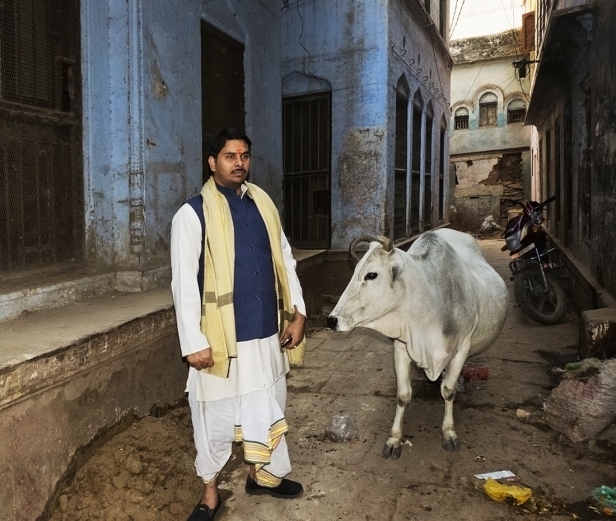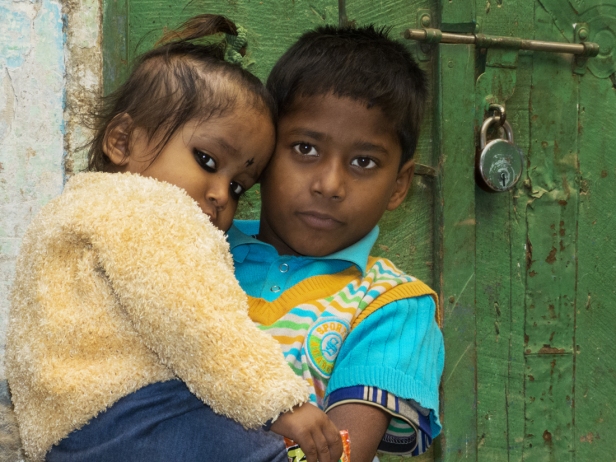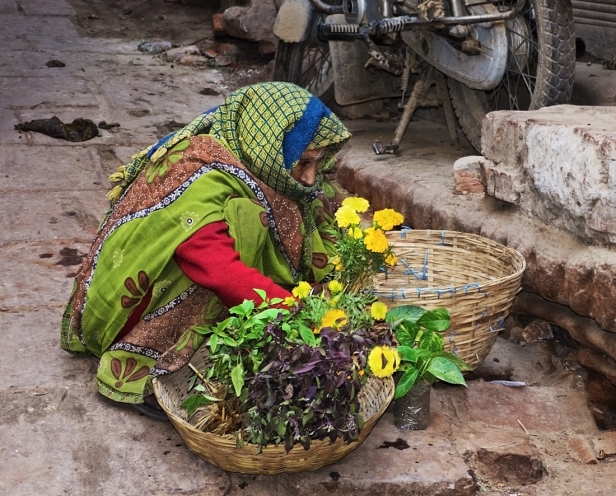December 2-8, 2012. I’m glad Varanasi was the last stop on our six-week odyssey through India. Everywhere else we’ve been, including the camel fair in Pushkar, has been amazing and exciting and enriching in many ways, but nothing compares with Varanasi. It is a holy city on a holy river. Nowhere else in the world is a river worshipped as a god, and that sense of devotion pervades Varanasi. It is a special place, and everyone who lives here knows it. And many come from all over India to live here because of it. We’d saved the best ‘til last. Varanasi is jaw dropping; more than any other city we’d visited in India.
It was only after arriving that I found out I was in Benares, a city I’d known about for years. When I say “known about” I mean that it had crept somewhere into the depths of my psyche as the holy city of Benares way back when I was a child at the same time that I learned of cities called Bombay and Calcutta. I didn’t understand what was meant by holy city. To my child’s mind that was something strange and foreign, and nobody explained it to me. But somehow knowing that I was in Benares made it different, more special: I am in the holy city of Benares! The city is still known as Benares, as much as Varanasi, and I prefer Benares, probably because of the intrigue created in me as a child. Apparently it is one of the oldest, if not the oldest continuously inhabited city in the world. When walking down the narrow alleys in the old part of town above the Ghats it’s easy to believe that.
When we arrived we had to walk for fifteen minutes to get to our hotel. There’s a limit to how far cars can get into the town. There were two porters to greet us on our arrival. We had four cases between us, and were a bit perturbed as to how they were going to carry them all, but they nonchalantly, seriously, nonchalantly piled two apiece on their heads and set off at a great rate. They were probably carrying about forty kilos each. We were almost running to keep up with them. On and on they went through narrow alleys, past the cows and cow poop, people, dogs and motor bikes: twisting and turning, heading down some stairs, ducking low in places, until finally we could see the river, and a kind of dirt shelf with more cows, and just a few steps lower, our hotel.

Most of Benares is much like any other Indian city and we didn’t spend any time there. But the old town, the original city down by the Ganges, by the Mother Ganga, is something else. It’s a maze of narrow twisting alleyways that grew organically over the centuries with no thought of transportation other than by foot or donkey. You can easily become lost. Our hotel was right down on the Ghats and overlooking the river so we knew if we ever got lost we just needed to head down hill and eventually we’d come to the Ghats and could walk along by the river to get home.
This first post will be about the town. In the next post I’ll write about life on the Ghats and life on the river. To separate the two has no real validity but I had to find a way to sort through all my thoughts and all my photos. To separate the town of Benares from the Ghats and the Ganga is like those lines on a map that separate one country from another, lines drawn after wars by men in other places, that have little relevance for the people that actually live there. Benares exists because of the Ganga.
The old town of Benares, even with it’s overlay of modernity such as electricity and motorbikes, cell phones, and the internet, still continues in much the same way it has for thousands of years. Laundry is done by hand, food is cooked over open fires, curd is made in the same way over fires in a tiny space inside a building that has existed for hundreds of years, and vendors still spread their goods on the ground for sale.
In this small space curd is being made – there’s a small fire under each pan.

We found the Brown Bread Bakery, with a sign saying “As recommended on TripAdvisor” – it was okay, but nothing special. The next day, further down the same alley we found the real Brown Bread Bakery, which has a fabulous rooftop restaurant, and lower down a lounge room where you could also eat. They have live music every night. We went there many times. At the time I wrote: Sitting amongst the cushions on the floor listening to the best live sarod and tabla music, while eating ice-cream with chocolate sauce. All is right with the world.
The narrow winding streets of Benares







Getting some candy on the way home from school

We wandered the narrow alleyways, unconcerned about getting lost, curious about everything. We talked to people, went into temples, and got glimpses into the homes and everyday lives of those who live there. These are some of the people we encountered on our wanderings:







The interior of one of the many temples

Everyone has something for sale







This man sits on a narrow stone shelf and makes little chewable packages wrapped in leaves. The main ingredient is betel nut, but other things are also added.

There’s a lot more I want to write about this place, about the river and the life on it, and in it, about the burning of the dead, about the religious practices, and the beliefs held by the people of India about the river and this city. All of that in the next post.
All words and images by Alison Louise Armstrong unless otherwise noted.
© Alison Louise Armstrong and Adventures in Wonderland – a pilgrimage of the heart, 2010-2015.

Did you also know that Benares is where Kabir lived among the Muslim weaving community that still exists today a bit outside the main city. They are the ones who weave the gorgeous Benares silk saris, living in poor conditions while the middle-men get all the profit. Still, according to a friend who visited them, they are quite proud of their work. Great photos…… Benares is a magical one-of-a-kind city for sure! Shanti….kai
LikeLiked by 1 person
No, didn’t know Kabir lived there. Wish I’d known about the Muslim weaving community, would have gone to visit that.
Yes it is a magical city.
I was re-reading a post I wrote about Venice last night and wrote it’s hard to believe it’s real, or something like that. Benares is the same. Hard to believe it’s real, that such a place exists.
LikeLike
Forgive me if somewhere along the way I missed seeing this but are you turning this into a book? The photos and journey telling are so marvelous, the photos with the brilliant colors interspersed with so much poverty really captures the dichotomy of life. This blog site is a treasure. Paulette
LikeLiked by 1 person
Thank you for your kind words! So encouraging.
Yes there has always been a book planned. We’ve made a start – about the very beginning when we made the decision to sell everything and become nomadic, about the time it took us to actually do it, the inner changes and grieving and letting go we faced. We both wrote every day at the time and we’ve started editing through all those notes.
Next time we get back to it will probably be in April/May when we plan to stay put in Mexico for a while.
LikeLiked by 1 person
This is one book I look forward to reading. Meanwhile stay healthy and continue to enjoy! Paulette
LikeLiked by 1 person
Wonderful photos, the kind I see in travel magazines and photo books. And here.
LikeLiked by 1 person
Thank you so much. Glad you like them.
LikeLike
A.M.A.Z.I.N.G.!!!! Thank you for bringing us to Benares with you!
LikeLiked by 1 person
Thank you! And you’re welcome. I love doing this blog. And I love that people enjoy it.
LikeLike
My exact sentiment, great photos!!
LikeLike
Thanks. Glad you enjoyed it.
LikeLike
Great photos! And lovely to see so many people reading the newspaper 🙂
LikeLiked by 1 person
Thanks. Everyone reads the paper 🙂
Back in Van for worlds. We must have a not-at-worlds get together so I can see everyone!
LikeLike
Did you buy the famous Banaras Silk Sari while you were there? Its one of a kind.
And lots of street travelling you did. 😀
Kudos!!!
LikeLiked by 1 person
No, didn’t buy a sari – no room in our tiny suitcases 🙂
Love street travelling – walking around whatever city we’re in, away from the regular tourist paths. It’s usually just as interesting, and sometimes even more so. Still fascinated by all the different ways in which people live.
LikeLike
Have seen Benares many times in films and documentaries, but your personal account is unique, Alison. I love the shot of the bicycle, the man reading a newspaper, and, of course, the children.
Your next post has me so intrigued. I feel like a Harry Potter fan waiting for the next book.
I agree with others who have said that you need to publish a book.
{{{Hugs}}} Kozo
LikeLiked by 1 person
Thanks Kozo.
Next post coming soon 🙂
And yes, a book eventually, but no breath-holding 🙂
LikeLike
I love seeing your photos of people and places. Makes me want to pack a suitcase.
LikeLiked by 1 person
Thanks Danny.
Oh go on. Do it. Pack a suitcase 🙂
LikeLike
We visited India some years ago, and like you, had to stop in Varanasi. And what an incredible place. It was an assault on the senses in every way, but boy, what an education. I particularly remember scenes of worshippers on the Ganges River. What a scene! Your words and excellent pictures bring back lots of memories. Thanks.
LikeLiked by 1 person
Thanks, and you’re welcome!
Pics of worshippers, and people doing laundry, and people in boats, and people bathing, and people who live on the Ghats, and . . ., etc etc to come in the next post all about life on the river. As you say – an assault on the senses.
LikeLike
amazing trip, thanks for sharing these vivid pictures with us. ☼
LikeLiked by 1 person
Thanks! My pleasure. So glad you’re enjoying it.
LikeLike
I can’t wait to visit! Your photos are stunning 🙂
LikeLiked by 1 person
Thanks Lakshmi.
I’m sure you’ll have an amazing time. Make sure you get to the right German Bakery 🙂
LikeLike
I certainly will…I love the German bakery in Puttaparthi too!
LikeLiked by 1 person
Reblogged this on LAKSHMI LOVES TO SHOP and commented:
Padma and I definitely have Varanasi on our “must-see” list for our trip this year. This delightful post from my well-travelled friend Alison perfectly captures amazing Varanasi…Namaste…
LikeLiked by 1 person
Thank you. I’m just thrilled!
xox
LikeLike
Amazing. I loved Varanasi and since it was a short trip for me, I could only do a boat ride in the morning which unfolded the character of the city. I loved your post and hope to visit again to experience Varanasi.
LikeLiked by 1 person
Thank you so much. I’m glad you enjoyed it. You might also enjoy my second post on Varanasi where I focus on life on the Ganges
https://alisonanddon.wordpress.com/2013/02/10/india-part-15-varanasi-the-holy-city-of-benares/
I’m now off to explore your blog – I love your idea that live is a vacation. Indeed it is. Attitude is everything!
Blessings
Alison
LikeLike
Amazing pictures, I lived the city all over again. You are ever so right about the burning ghats. In Kathmandu, I have seen burning a pyre and the evening arati going on at the same time on two sides of the river. The dead are not dead, it is an inflexion point to come back again since I believe in re-incarnation. Here is my post on Varanasi…
LikeLike
I too believe in reincarnation . Glad you enjoyed the post. Loved yours. I’d love to go to Kathmandu – I haven’t been there yet. It must have been amazing to see the aarti and pyres at the same time.
Alison
LikeLike
Amazing pictures, wonderfully written tale about Varanasi. Superb:)
LikeLiked by 1 person
Thank you so very much. I’m glad you enjoyed it. There’s a second post on Varanasi, this one focusing on the Ganges: https://alisonanddon.wordpress.com/2013/02/10/india-part-15-varanasi-the-holy-city-of-benares/
Blessings
Alison
LikeLike
Amazing! Im happy i found this post in Lakshimi, thanks for this great post!
LikeLiked by 1 person
Thank you so much. Varanasi is so extraordinary, one of the most amazing places we visited.
LikeLike
Hi Alison…
I belong to Varanasi.. n everytime I find travellers like you visit this holy city n admire it.. I feel on top of this world.. Varanasi indeed is a beautiful city… even I’ve not seen my city completely 😦
Great pics.. seeing them I recalled how when walking on those busy n narrow streets I used to see travellers like you, enjoying each n every moment of Varanasi, getting accustomed to the life style…
It’s been quite sometime I visited Varanasi, thru your pics I was trying to identify those streets, ghats…
Thanks a tonne for visiting my place… our place…. 🙂 for sharing those amazing pics n writing those beautiful words for Varanasi… We would love to see you again n again.. 🙂 🙂
LikeLiked by 1 person
Hello Pratiksha, nice to meet you. Thank you for all your nice words about our post. In case you’re interested there’s another post about your beloved Varanasi focusing on life on the Ganga:
https://alisonanddon.wordpress.com/2013/02/10/india-part-15-varanasi-the-holy-city-of-benares/
I think it’s a better post than this one.
Thank you for following . I hope you enjoy the stories of our journeys, both inner and outer.
I hope you get home to Varanasi one day. And I hope we get to return one day 🙂
Namaste
Alison
LikeLike
Namaste Alison.. I’ve read both posts.. thanks for sharing! 🙂 🙂
I really enjoyed your journey… n wish to see you once again in Varanasi 🙂 🙂
LikeLike
Just absolutely stunning! Bravo! Hope you both are doing well & cheers~
LikeLike
Thank you so much Cindy. Yes, we’re both well thanks, though suffering mildly with altitude at the moment. We just went from sea level to about 2900 metres. We keep doing these mad jumps up and down. Still we know what to expect now and it passes. I’ve been loving your Caribbean posts. We’re close (Ecuador), but no cigar – we head back to Van (briefly) near the end of March. Central America and Caribbean will be for another trip.
LikeLike
Hi Alison,
The pictures you have clicked are really very lively and they give a lot of information about the character of varanasi! I am a student of architecture and i am studying and researching about varanasi for my project, thanks to you; your pictures convey a lot for my study, every little detail like the small openings to the houses, narrow compact lanes and ornamentation on the doors and windows has helped me to move forward in my project.
I wanted to know if you visited any silk weaver’s house. My project is aiming to help silk weavers in varanasi for which i need some pictures of the weaver’s house which would help in in designing better spaces for them.
LikeLike
Thanks so much Sharvari, I’m glad my photos have helped you. Unfortunately we didn’t visit the homes of silk weavers.
Namaste
Alison
LikeLike
Such a beautiful post Alison, I can feel your awe and wonder.
My familiarity with the beliefs and customs, and disappointment over my experience at the Kashi Vishwanath temple, came between me and my enjoyment of Varanasi. And the fact that we went during the rains and couldn’t shake the overpowering smell of dung even hours after we returned to our hotel far from the ghats, contributed to the title of my post: Surviving Kashi! I really need to return in the right season, and in a better frame of mind 🙂
LikeLiked by 2 people
Thanks Madhu. We were completely awed by Kashi, and Don, who swears he’ll never go back to India would go back to Kashi. Oh I can’t imagine what it would be like in the rainy season! Maybe one day you’ll go back and, avoiding both rains and the temple, see it with fresh eyes.
Alison
LikeLike